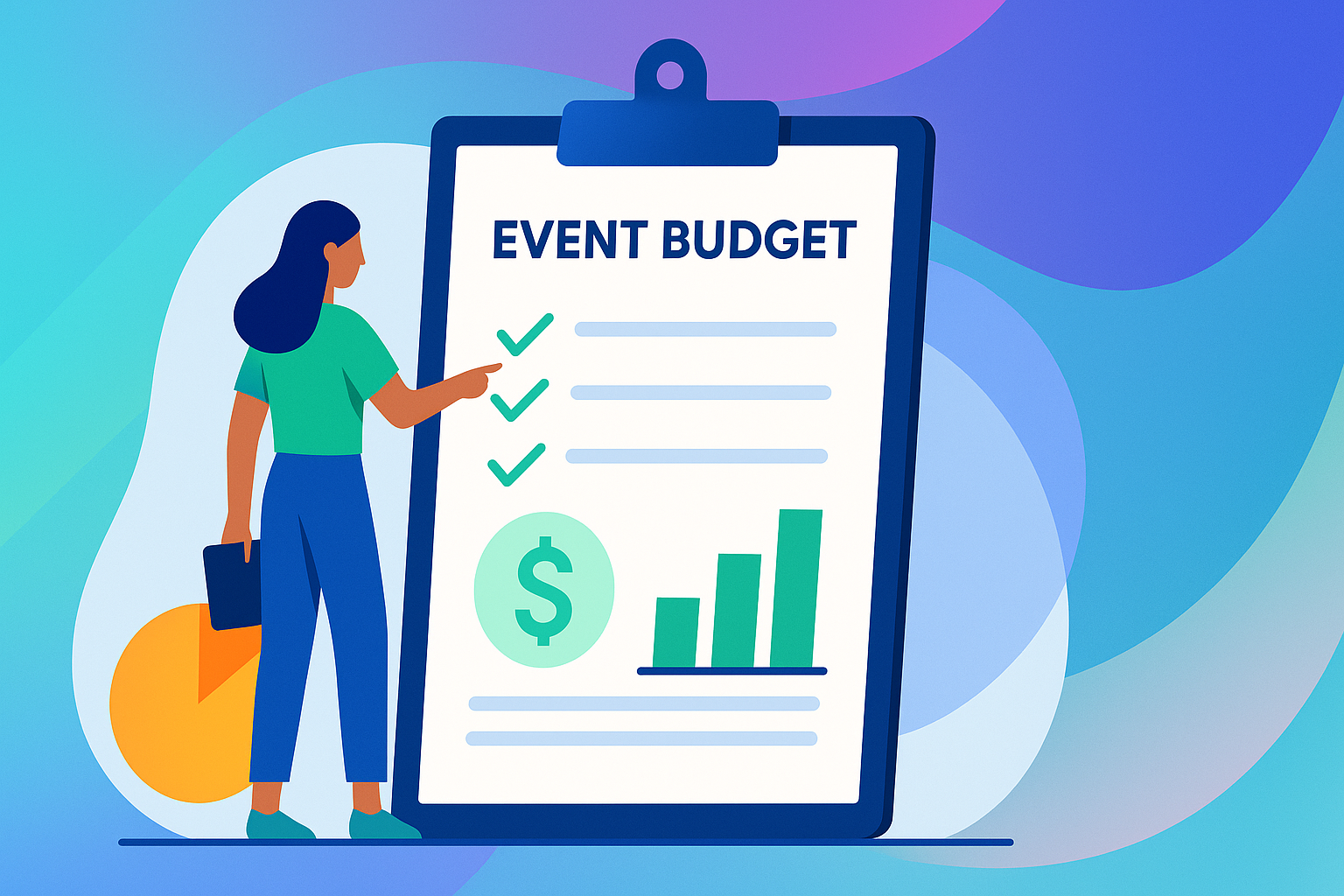How to Build an Effective Event Budget

Planning a live event can feel overwhelming, but it doesn’t have to be. A clear event budget gives you the control and confidence to focus on what really matters: delivering an amazing experience for your attendees and sponsors.
A well-structured event budget template helps you:
- Control costs by tracking every expense
- Prepare for surprises by reserving 10–15% of your budget
- Set priorities by allocating funds to high-impact areas like venues, catering, and marketing
- Track event expenses in real time
- Measure ROI by comparing planned vs. actual results
1. Define Your Event Goals
Every strong budget starts with clarity. Ask yourself:
- Why are we hosting this event?
- Who are we serving (attendees, sponsors, members)?
- What results will make this event successful?
Set SMART goals: specific, measurable, achievable, relevant, and time-bound. For example, a community festival might aim to increase local attendance by 20%, while an annual gala might target $50,000 in sponsorship revenue.
Actionable Insight: Write your top three goals at the top of your budget sheet. This keeps every line item tied to your outcomes.
2. Estimate Attendance
Your projected attendance drives most of your costs:
- Venue: Larger spaces cost more to rent and set up
- Variable costs: Catering, registration materials, and giveaways scale with headcount
- Revenue planning: Ticket pricing and sponsorship packages depend on turnout
Actionable Insight: Plan three scenarios conservative, expected, and stretch, so you can flex your budget as registrations come in.
3. Identify Budget Categories
Organize your spending into clear categories by starting with an event budget template that includes all the essential line items for venues, marketing, staff, and technical needs. A practical event budget template should include:
| Category | Key Considerations |
|---|---|
| Venue & Logistics | Rental fees, permits, setup, AV equipment |
| Program Elements | Speakers, entertainment, printed or digital content |
| Attendee Experience | Catering, registration, décor, swag |
| Marketing & Promotion | Digital ads, signage, branding materials |
| Technical Needs | Event management software, Wi-Fi, streaming tools |
| Staff & Support | Coordinators, volunteers, security, technical help |
Actionable Insight: If your event has hybrid elements, separate in-person and virtual costs. This makes it easier to track ROI for each format.
4. Research and Track Event Expenses
Accurate estimates mean fewer surprises later.
- Get Multiple Quotes: Always compare at least three vendors for major costs like catering or AV.
- Review Past Events: Look at what you spent last year or at similar events to avoid underbudgeting.
- Use Event Management Software: Instead of juggling spreadsheets, platforms like ClearEvent's event management software give you pre-built categories, dashboards, and real-time updates that simplify budget tracking.
Actionable Insight: Store all vendor quotes in one folder so your team can easily review and approve them.
5. Manage Costs in Real Time
Budgeting isn’t “set and forget.” To truly track event expenses, you need ongoing visibility.
- Log both estimated and actual costs
- Review your budget weekly during planning
- Flag overruns early and reallocate funds if needed
- Track sponsorship revenue alongside expenses to calculate ROI
Actionable Insight: Use built-in reports to clearly demonstrate the value of sponsorship investment. This strengthens relationships and boosts future sponsorship ROI.
6. Build in Contingency Funds
Even the best plans hit bumps. Weather, vendor cancellations, or last-minute requests can add costs. Reserve 10–15% of your total event budget as a safety net.
Actionable Insight: Label this fund clearly in your budget so stakeholders see you’ve planned for the unexpected, it builds trust and confidence.
7. Secure Stakeholder Approval
When presenting your budget to sponsors, committees, or leadership, highlight:
- Fixed vs. variable expenses
- Revenue projections (tickets, sponsorships, exhibitor fees)
- ROI potential
- Contingency planning
Clear, professional reports make approval faster and event management software makes it easy to generate these with one click.
8. Review Your Budget Post-Event
The real value of a budget shows up after the event. Compare what you planned against what you spent, and record insights for next time.
Key metrics to track:
- Financial Performance: Cost per attendee, overall ROI
- Marketing Efficiency: Cost per registration, conversion rates
- Operational Costs: Venue utilization, staffing ratios
- Revenue Sources: Sponsorships, ticket tiers, merchandise
Actionable Insight: Roll over your budget template to your next event. This saves hours of setup and gives you a head start with real historical data.
Conclusion
An event budget isn’t just paperwork, it’s a decision-making tool that keeps your event on track. It drives smarter planning, aligns your team, and proves value to sponsors and stakeholders.
With the right event budget template and modern event management software, you can track expenses in real time, avoid financial surprises, and clearly demonstrate sponsorship ROI.
ClearEvent provides pre-loaded categories, real-time dashboards, and built-in reporting to make budgeting simple for organizers like you. Whether you’re running a community festival, a corporate conference, or an annual gala, you’ll have everything you need to stay in control.
Next Step: Start your free 14-day trial of ClearEvent and see how easy it is to manage your next event budget with confidence.
Frequently Asked Questions (FAQ)
What should be included in an event budget template?
An effective event budget template should cover venue, catering, marketing, technical needs, staffing, and contingency funds. It should also include projected revenue from ticket sales and sponsorships so you can measure ROI accurately.
How much contingency should I set aside in my event budget?
Most planners recommend reserving 10–15% of your total budget for unexpected costs. This buffer helps cover last-minute vendor fees, weather-related changes, or technical issues without derailing your event.
What’s the best way to track event expenses in real time?
Using event management software is the most efficient option. Platforms like ClearEvent provide dashboards and built-in reporting so you can compare estimated vs. actual costs as you go, making it easier to stay on budget.
How do I show sponsorship ROI in my event budget?
Track all sponsorship income against related expenses, then report on measurable outcomes like cost per attendee, brand visibility, or attendee engagement. Clear, data-driven reports help demonstrate value and strengthen future sponsorship opportunities.
Do I still need a budget if my event is free to attend?
Yes! Even free events have expenses like venue rentals, marketing, and volunteer coordination. A budget ensures you stay within your financial limits and helps you demonstrate responsible planning to sponsors and stakeholders.
